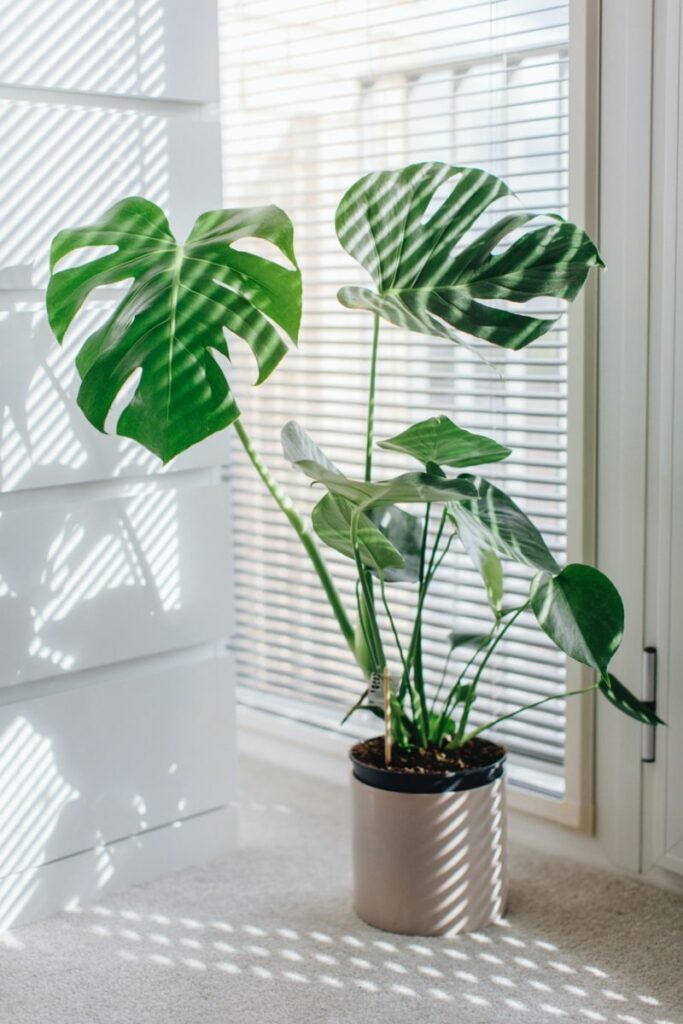Monstera plants are iconic in the houseplant world, with their signature fenestrated leaves that can reach several feet in width. New growers and Monstera experts alike have frequently asked the same question on these stunning plants – just how fast do monsteras grow, exactly? If you’re a new plant parent with a small vining Monstera, or have a larger plant and looking to maximize it’s beauty, read along as we dive into Monstera growth rates so you can help your plant reach its full potential!
Understanding Monstera Growth Rates
Monstera plants are a sight to behold with their large, glossy leaves with fenestrated outlines. These tropical plants are native to Central and South America and have become a popular houseplant choice for their easy care and striking appearance. But, have you ever wondered how fast Monsteras grow? Well, the answer is not so simple and depends on several factors like lighting, water, humidity and age.
Monsteras grow rates can vary depending on a variety of factors, including the plant’s age, environment, and care. It’s a complex process that requires a lot of attention to detail. Generally, younger Monstera plants will grow faster than older ones, as they are still developing their root systems and establishing themselves in their environment. However, even mature Monstera plants can experience growth spurts under the right conditions.
The environment in which a Monstera plant is grown can also impact its growth rate. These plants thrive in warm, humid conditions and require bright, indirect light to grow properly. If a Monstera is grown in a cooler, drier environment or in low light conditions, its growth rate may slow down significantly. It’s like trying to run a marathon in the middle of winter with no training. You’re not going to perform at your best.
Finally, proper care is essential for promoting healthy Monstera growth. These plants require regular watering, but overwatering can lead to root rot and stunted growth. Fertilizing with a balanced, all-purpose plant food can also help promote healthy growth. It’s like giving your body the right nutrients to perform at its best.
In general, Monstera plants can grow up to several feet per year under ideal conditions. However, growth rates can vary significantly depending on the factors mentioned above. It’s like trying to predict the weather. You never know what you’re going to get. By understanding the factors that impact Monstera growth rates, you can help ensure that your plant thrives and grows to its full potential. So, take care of your Monstera plant and watch it flourish into a beautiful, thriving specimen.
Factors Affecting Monstera Growth

Monstera plants are a fascinating species that are renowned for their large, glossy leaves and unique, holey appearance. These tropical plants are highly sought after by houseplant enthusiasts due to their striking appearance and easy care. Monsteras grow at different speeds, depending on several plant care factors that are easy to perfect.
One of the most critical factors that can affect the growth rate of a Monstera plant is light. These plants require bright, indirect light to thrive, and insufficient light can slow down growth and cause the leaves to become smaller and less vibrant. Conversely, too much direct sunlight can scorch the leaves and stunt growth, which can be detrimental to the plant’s overall health.
Temperature is another crucial factor that can impact the growth rate of a Monstera plant. These plants prefer warm temperatures between 65-85°F, and cooler temperatures can slow down growth. On the other hand, temperatures above 90°F can cause the leaves to wilt and dry out, which can be detrimental to the plant’s health.
Humidity is also a critical factor that can affect the growth rate of a Monstera plant. These plants are native to tropical regions and thrive in high humidity environments. Low humidity levels can cause the leaves to dry out and slow down growth, which can be detrimental to the plant’s overall health. Using a humidifier or placing a tray of water near the plant can help increase humidity levels and promote healthy growth.
Soil is another essential factor that can impact the growth rate of a Monstera plant. These plants prefer well-draining soil that is rich in organic matter. Soil that is too compact or lacks nutrients can slow down growth and cause the leaves to become yellow or brown, which can be detrimental to the plant’s overall health.
Watering is also a crucial factor that can affect the growth rate of a Monstera plant. Overwatering or underwatering can both affect the growth rate of a Monstera plant. Too much water can cause root rot and slow down growth, while too little water can cause the leaves to wilt and dry out, which can be detrimental to the plant’s overall health.
Overall, Monstera plants can grow relatively quickly under the right conditions. With proper care and attention to these factors, you can help your Monstera plant reach its full potential and achieve its signature, impressive size. So, make sure to take care of your Monstera plant and provide it with the right conditions to thrive!
Ideal Growing Conditions for Monstera Plants

Monstera plants are renowned for their rapid growth rate, but achieving optimal growth requires specific growing conditions. To ensure your Monstera plant flourishes, here are some ideal growing conditions to consider:
Light
Monstera plants thrive in bright, indirect light. While they can tolerate some direct sunlight, excessive exposure can scorch their leaves. Therefore, it’s best to place your Monstera plant near a window that receives bright, filtered light.
Temperature
Monstera plants prefer warm temperatures between 65-85°F (18-29°C). Although they can tolerate slightly cooler temperatures, it’s best to avoid exposing them to temperatures below 50°F (10°C).
Humidity
Monstera plants prefer high humidity levels between 60-80%. You can increase humidity levels by misting the leaves regularly or placing a humidifier near the plant.
Soil
Monstera plants require well-draining soil that retains moisture. A mixture of peat moss, perlite, and vermiculite is ideal for Monstera plants.
Watering
Monstera plants prefer consistently moist soil, but overwatering can lead to root rot. Therefore, it’s best to water your Monstera plant when the top inch of soil feels dry to the touch.
By providing these ideal growing conditions, your Monstera plant will grow quickly and thrive.
Tips for Promoting Faster Monstera Growth

If you’re seeking to expedite the growth of your Monstera plant, there are a plethora of tips you can follow to help promote faster growth. Here are some of the best ways to encourage your Monstera to grow quickly:
Provide Adequate Light
Monstera plants thrive in bright, indirect light. If your plant isn’t getting enough light, it may grow more slowly. Make sure your Monstera is placed in a spot where it can receive plenty of natural light, or consider using grow lights to supplement its light intake.
Water Regularly
Monstera plants need to be watered regularly to keep their soil moist. However, be careful not to overwater your plant, as this can lead to root rot. Water your Monstera when the top inch of soil feels dry to the touch.
Fertilize Monthly
Monstera plants benefit from regular fertilization. Use a balanced, water-soluble fertilizer once a month during the growing season to help promote faster growth.
Prune Regularly
Pruning your Monstera can help encourage new growth. Remove any dead or damaged leaves, as well as any stems that are growing in the wrong direction. This will help redirect the plant’s energy towards new growth.
Repot When Necessary
Monstera plants may need to be repotted every year or two, depending on their size and growth rate. If your plant is becoming root-bound, it may be time to repot it into a larger container. This will give the roots more room to grow and help promote faster growth overall.
By following these tips, you can help promote faster growth in your Monstera plant. With a little bit of care and attention, your Monstera will be thriving in no time!
Common Problems that Affect Monstera Growth

Monsteras are a popular houseplant due to their ease of care, but there are a few issues that can impede their growth. Here are some of the most common problems to keep an eye out for:
1. Overwatering can lead to root rot, which is why it’s important to ensure that the soil is well-draining. To avoid this, make sure to let the soil dry out slightly between waterings and avoid letting the plant sit in standing water.
2. Lack of light can cause monsteras to grow more slowly or develop smaller leaves. To ensure that your plant thrives, it’s important to provide it with bright, indirect light. If this isn’t possible, consider moving your plant to a brighter location or supplementing with artificial light.
3. Pests such as spider mites, mealybugs, and scale insects can damage the leaves and slow down growth. Keep an eye out for any signs of infestation and treat promptly if necessary.
4. Nutrient deficiencies can cause yellowing leaves or slow growth. To ensure that your monstera is getting the nutrients it needs, consider adding a balanced fertilizer to your watering routine.
By addressing these common problems, you can help ensure that your monstera grows quickly and stays healthy. With proper care, these plants can grow several feet per year and become a stunning focal point in any room.
Conclusion: How to Care for Your Monstera Plant and Encourage Healthy Growth

The Monstera plant is a fascinating specimen that can grow at an impressive rate if given the proper care. To ensure that your Monstera thrives, it is essential to provide it with the right amount of light, water, and nutrients. How fast do monsteras grow? In the right conditions, you can expect plants to send up a new leaf every 4-8 weeks, depending on your specific environmental factors.
When it comes to lighting, it is crucial to place your Monstera in a bright, indirect light location. Direct sunlight can be harmful to the plant, causing its leaves to scorch. As for watering, it is important to maintain a regular schedule, but be careful not to overdo it, as this can lead to root rot.
To provide your Monstera with the necessary nutrients, you can use a balanced, water-soluble fertilizer every two to four weeks during the growing season. Alternatively, you can opt for organic fertilizers, such as compost or worm castings, to give your plant the essential nutrients it needs.
Pruning your Monstera is also a crucial step in promoting healthy growth and preventing it from becoming too leggy. By removing any yellow or damaged leaves and trimming back long stems, you can encourage bushier growth.
With patience and dedication, you can watch your Monstera grow into a stunning, lush plant that will bring life and beauty to your home. So, follow these care tips, and your Monstera will reach its full potential in no time!
Frequently Asked Questions
How fast do monsteras grow?
Monsteras are known for their rapid growth rate, especially during the growing season. On average, a mature monstera can grow a new leaf every 4-8 weeks in ideal conditions. However, the growth rate can vary depending on various factors such as light, temperature, humidity, and soil conditions.
What is the best way to encourage monstera growth?
The best way to encourage monstera growth is to provide it with the right growing conditions. This includes bright, indirect light, warm temperatures, high humidity, and well-draining soil. Regular fertilization during the growing season can also help promote healthy growth.
Can monsteras grow in low light conditions?
While monsteras prefer bright, indirect light, they can tolerate low light conditions. However, this may slow down their growth rate and cause them to become leggy. If you want your monstera to thrive, it’s best to provide it with bright, indirect light.
How often should I water my monstera?
Monsteras prefer to be kept evenly moist but not waterlogged. It’s best to water them when the top inch of soil feels dry to the touch. During the growing season, you may need to water your monstera once a week or more frequently if it’s in a warm, dry environment. In the winter, you can reduce watering to once every two weeks or when the soil feels dry.
Do monsteras need to be repotted often?
Monsteras are known for their vigorous growth and may need to be repotted every 1-2 years. However, it’s best to wait until the plant has become root-bound before repotting. When repotting, choose a pot that is one size larger than the current pot and use a well-draining soil mix.

